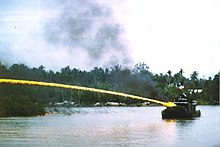Cold and wet damage to the hands or feet
| Classification according to ICD-10 | |
|---|---|
| T69.0 | Cold and wet damage to the hands or feet
Trench foot |
| ICD-10 online (WHO version 2019) | |
Cold wet damage of the hands or feet , known as trench foot , ( English immersion Foot Syndrome ), is a medical term for related variants of a complex multifactorial orellen syndrome, which is caused by prolonged exposure to moisture on human tissue in conjunction with solid footwear. Often the lower legs and in rare cases the hands are also affected.
Occur
The syndrome occurs mainly in conjunction with external water exposure, but can also occur in situations in which the footwear is not sufficiently breathable, sweat and body fluids collect in the shoe and the foot is stressed at the same time, such as walking. What all variants have in common is that the cornea swells and macerates , pathogens and fungi penetrate through wounds and trigger inflammations that, if left untreated, turn into necrosis and, in the worst case , can lead to death through multiple organ failure .
Military medical significance
To this day, the immersion foot is considered to be one of the most dreaded soldiers' diseases in military medicine , as it is still largely underestimated because of its banal origin and prevention, develops very quickly, and if left untreated, leads to death very quickly, therapeutically almost all areas of high-performance medicine and often leaves those affected suffering from profound medical and psychosocial effects for the rest of their lives due to subsequent severe disabilities. This is why most of the common names come from the language of the soldiers . Designations for sub-forms are (Schützen-) trench foot ( English non-freezing cold injury , abbreviated NFCI) for the progressive form in the temperature range from 0 ° C to max. 15 ° C, Dschungelfäule ( English hot water immersion foot , WWIF) for the waveform to above 35 ° C, Eintauchfuß (at shipwrecked specifically the Navy) or simply Soldatenfuß or Fußbrand (without specifying the circumstances).
Occurrence in civil situations

The syndrome can appear wherever tight-fitting footwear is kept on the foot for a long time and is at risk of being soaked through from external water or body fluids. The reasons for this can be of a professional nature (for example in the fish processing industry or in water, canal, dike and opencast mining), but leisure activities such as sailing , hiking or camping can also be a trigger. Rainy outdoor events (such as music festivals ) can also create these conditions. Groups of people in precarious situations, such as the homeless, abused children, refugees, prisoners and forced laborers (e.g. in concentration or other internment camps ) are also endangered by their living conditions .
Harmful components and associated symptoms
The complex harmful effect occurs when trench foot by the interaction of several components, alone the water with its physical properties of the isothermal osmosis , edema , washout of electrolytes among others vital nutrients and messengers and thermal osmosis (derivation of cell heat and cooling of the tissue environment cold by diffusion water, in a warmer area) brings multiple damaging factors with it, plus negative reinforcing, mechanical effects (abrasion, pressure from the outside) and surrounding exposure to germs, parasites and other pollutants dissolved in the water, such as. B. in war chemical warfare agents.
water
Similar to classic frostbite, four stages are also divided here:
- Stage 1: harmful effect ( english injury stage ):
- First a classic, cold, pale wash skin forms . The blood flow to the tissue is reduced and it feels numb. Limbs are pale or red but feel no pain.
- 2nd stage: Immediately after the harmful effect ( English immediate post-injury ):
- After warming up, the body part changes color, often from white to red or blue, and can swell up to twice or three times its original size.
- 3. Hyperemic phase:
- This phase can last two weeks to three months and is accompanied by severe neuralgic pain. The skin is dry and may blister.
- 4. Post-hyperemic phase:
- The tissue is irreparably damaged and has fewer nerve endings than healthy ones. Neuralgic problems can persist until the end of life, ulcers and tumors can develop.
As long as the part of the body was “only” influenced by water, the therapy mainly consists of letting the affected tissue dry out intensively and rebuilding the tissue that has been washed out and hypothermic by the action of water using creams and ointments.
Mechanical action
The next component is the mechanical impact: the skin begins to peel off, usually aided by chafing of the footwear and wet socks, and the underlying tissue is bare. Deep abrasions and detachment of tissue, even tearing off fasciae, muscles and joints, can occur, which usually leads to autoimmune responses such as inflammation and fever.
Germs and parasites
The third harmful component are surrounding germs and parasites, which penetrate the open wounds, intensify inflammation and in turn attack the exposed tissue and form necrosis . If the pathogens get into the bloodstream, they can trigger sepsis , which leads to early death.
Chemical pollutants
The fourth harmful component with protracted long-term consequences are pollutants introduced into the surrounding water and mud, which occur particularly frequently in wars and can also have a poisonous and carcinogenic effect.
Cultural history
The syndrome was first described by Dominique Jean Larrey in the Napoleonic Wars at the beginning of the 19th century ; no reports are known before that. The occurrence coincides with the systematic spread of closed lace-up or combat boots as soldiers' footwear ; There are increasing reports from various wars of the 19th century, for example from the Crimean War .
In contrast to the wars of post-antiquity in Europe, the Middle Ages and the early modern period, when every soldier was largely responsible for his own equipment and the armies therefore usually presented the appearance of a colorful hodgepodge of individuals who often fought barefoot, at the latest one began with Introducing the standing army , introducing uniform uniforms, and providing the recruits with closed, sturdy shoes and other clothing that few could have afforded before. However, the quality, weather resistance and accuracy of fit of the equipment were also a constant source of resentment and complaints about foot deformities and diseases caused by the footwear. The immersion foot only became a mass phenomenon in the First World War , when up to 50% of the soldiers in both war camps were affected in 1914 and 1915. The military doctors established a connection with water when they first noticed that the syndrome, unlike frostbite or frostbite , also occurs at temperatures above freezing point. Water was omnipresent in the trenches of that time, so that the name Grabenfuß established itself.
The disease is described to this day in wars and other situations in which soldiers are forced to remain in a wet environment for a long time, such as. B. the Vietnam War (jungle rot) or most recently with ISAF operations in countries like Afghanistan , where recruits and officers cannot take off their boots during long patrols.
Preventive measures and therapy
The only way to counteract this ailment in advance is to consistently dry or keep feet and legs dry. In order to stop the disease in its early stages, the wet skin on the feet and legs must be dried out for at least ten hours. During World War I soldiers were advised to “seal” their feet with cod liver oil, and so-called “trench boots” were issued, forerunners of today's rubber boots , which were made of waterproof fabric and leather. Wooden bridges and footpaths were built for the trenches so that water contact was kept as low as possible.
If the foot is already sick, the therapy depends on the stage of tissue destruction. As long as the skin is still intact, externally applied antimycotics (for fungal infections), antibiotics (for inflammation with bacteria) and antivirals help to prevent them from spreading to the deeper layers of the skin and the rest of the body. If tissue and maybe even bones are already affected, only amputations and transplants with subsequent physiotherapy are possible.
Web links
- https://www.ncbi.nlm.nih.gov/books/NBK482364/#!po=2.63158
- https://history.amedd.army.mil/booksdocs/wwii/ColdInjury/Chapter03.htm
- https://www.spiegel.de/geschichte/soldatenalltag-im-ersten-weltkrieg-a-948008.html
- https://publizistikon.blogspot.com/2015/01/100-jahre-erster-weltkrieg-der-grabenfu.html?m=1
- https://wehrmed.de/article/3548-lost-man-days-der-gram-negative-fussinfekt.html
- https://spartacus-educational.com/FWWfoot.htm
- https://www.linternaute.com/actualite/histoire/1362075-ces-images-censurees-pendant-la-grande-guerre/1362568-ampute-des-deux-pieds
- https://microbiologysociety.org/publication/past-issues/world-war-i/article/a-microbiological-cause-for-trench-foot.html
- https://gesund-pilgern.de/buch/grabenfuss.htm
- https://www.independent.co.uk/news/world/europe/refugees-calais-suffering-trench-foot-squalid-conditions-take-their-toll-children-diagnosed-sleeping-a7905006.html
- https://www.independent.co.uk/arts-entertainment/music/festivals/glastonbury-2015-medics-prepare-for-cases-of-trench-foot-10344152.html
- http://de.boatinsea.com/_2198/news/20307.php#.XoHY8KabFIk
Individual evidence
- ↑ Article about new soldier boots on the homepage of the US Army from March 3, 2017, accessed on April 2, 2020
- ↑ Article in Medical News Today, medical journal, January 30, 2018, accessed April 2, 2020.
- ↑ UpToDate. Retrieved April 4, 2020 .
- ↑ Derek Gregory: jungle red. Retrieved April 4, 2020 .
- ↑ Charity helping homeless people affected with trench-foot. Retrieved April 4, 2020 .
- ^ 'Barbaric' child cruelty couple jailed. Retrieved April 5, 2020 .
- ↑ Trench Foot discovery Could pave the way for new treatments | Imperial News | Imperial College London. Retrieved April 2, 2020 .
- ↑ Case report on the reimbursement of treatment costs for foot disorders and cancer of a Vietnam veteran as a long-term consequence of jungle rot in connection with Agent Orange (2011), accessed April 3, 2020
- ↑ Anne Sudrow: The Shoe in National Socialism. A product story in a German-British-American comparison . Wallstein, Göttingen 2010, p. 379.
- ↑ Article in the Medical Tribune , military medical monthly journal of January 15, 2019, accessed on April 1, 2020.
- ↑ Trench boots. In: Mémorial de Verdun. November 3, 2015, accessed on March 29, 2020 (German).
- ↑ Treatment of the syndrome in US soldiers 1944, accessed April 1, 2020.





